NAT 10.7%
Incumbent MP
John Cobb, since 2007. Previously Member for Parkes 2001-2007.
Geography
Central West NSW. Calare covers the towns of Bathurst, Lithgow, Blayney, Orange, Oberon, Parkes and Forbes, as well as other areas around those towns.
History
Calare was first created for the 1906 election, replacing the abolished seat of Canobolas. The seat has been held by all political parties over the last century.
The seat was first won by Thomas Brown (ALP) in 1906. Brown had previously held Canobolas since 1901, and he held the seat until he was defeated in 1913 by Henry Pigott of the Commonwealth Liberal Party. He held the seat for the Liberals and the Nationalists until he was defeated by Thomas Lavelle (ALP) in 1919.
Lavelle was defeated in 1922 by Major General Neville Howse, who won the seat for the Nationalists. Pigott had also contested the seat unsuccessfully for the new Country Party. Howse won a Victoria Cross during the Boer War and went on to serve as a senior officer in the First World War.
Howse served as a minister in the Stanley Bruce government before losing his seat in 1929 to George Gibbons (ALP), who was defeated by Harold Thorby of the Country Party at the next election. Thorby had previously been a state minister and went on to serve as a minister in Joseph Lyons’ federal government.
Thorby was defeated by John Breen (ALP) in 1940, and Breen held the seat until his defeat in 1946 by John Howse (LIB), the son of the former member for the seat Neville Howse.
Howse junior held the seat until his resignation in 1960. John England of the Country Party won the seat in the following by-election, and held it until the 1975 election. The seat was then won by Sandy Mackenzie.
Sandy Mackenzie lost the seat to David Simmons (ALP) in 1983. Simmons served as a federal minister from 1989 to 1993, and retired at the 1996 election.
The seat was won in 1996 by former television journalist Peter Andren, running as an independent. Andren won the seat on a 29% primary vote in 1996, with the ALP, Nationals and Liberals all polling less. Andren won 63% of the two-party preferred vote against the Nationals.
Andren set out an independent path, pursuing progressive politics while promoting regional interests. He was re-elected in 1998, 2001 and 2004 with over 70% of the two-party preferred vote.
The 2007 election saw the seat of Calare effectively abolished in its existing form, and Andren announced plans to run for the Senate in New South Wales. However, he was diagnosed with cancer and cancelled his plans to run for the Senate and decided to retire. Andren died of cancer in early November 2007, and the seat was won by John Cobb (NAT), then a junior minister in the Howard government and Member for Parkes.
In 2010, Calare was recreated in its previous form, losing areas in the northwest of the state gained in 2007, and regaining those areas lost to Macquarie in 2007. Cobb increased his margin from 53.5% to 60.7%.
Candidates
- John Cobb (Nationals)
- Billie Kirkland (Katter’s Australian Party)
- Ian Scott Lyons (Christian Democratic Party)
- Jess Jennings (Labor)
- Macgregor Ross (Independent)
- Brian Cain (Palmer United Party)
- David Mallard (Greens)
- Anthony Craig (Democratic Labour Party)
- Peter Schultze (Australia First)
Assessment
Calare is a safe Nationals seat.
2010 result
| Candidate | Party | Votes | % | Swing |
| John Cobb | NAT | 46,775 | 52.41 | +25.91 |
| Kevin Duffy | ALP | 25,926 | 29.05 | -4.42 |
| Jeremy Buckingham | GRN | 5,354 | 6.00 | +1.82 |
| Paul Blanch | IND | 4,137 | 4.64 | +4.64 |
| Karen Romano | IND | 3,276 | 3.67 | +3.67 |
| Jessyka Norsworthy | CDP | 1,957 | 2.19 | +1.65 |
| Macgregor Ross | IND | 1,817 | 2.04 | +2.04 |
2010 two-candidate-preferred result
| Candidate | Party | Votes | % | Swing |
| John Cobb | NAT | 54,209 | 60.74 | +7.28 |
| Kevin Duffy | ALP | 35,033 | 39.26 | -7.28 |
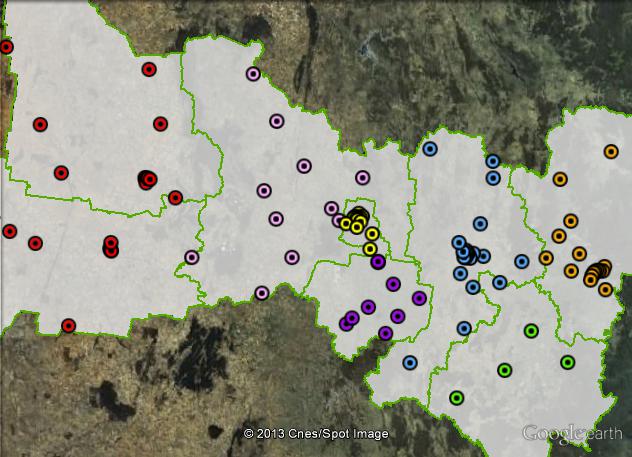
Booth breakdown
Booths have been divided into six areas. Polling places in Forbes and Parkes council areas have been grouped as “west”, and polling places in the other five local council areas of Orange, Bathurst, Lithgow, Cabonne and Blayney were grouped together along council boundaries.
The Nationals won a two-party majority in five out of six areas, ranging from 55.9% in Bathurst to 71.5% in Cabonne. The ALP won a 56.9% in Lithgow.
| Voter group | GRN % | NAT 2PP % | Total votes | % of votes |
| Orange | 6.52 | 62.30 | 18,023 | 20.20 |
| Bathurst | 7.81 | 55.91 | 16,408 | 18.39 |
| West | 2.57 | 71.13 | 11,827 | 13.25 |
| Lithgow | 5.37 | 43.10 | 9,560 | 10.71 |
| Cabonne | 4.78 | 71.54 | 5,751 | 6.44 |
| Blayney | 5.39 | 67.41 | 3,857 | 4.32 |
| Oberon | 3.89 | 66.18 | 2,342 | 2.62 |
| Other votes | 7.02 | 60.59 | 21,474 | 24.06 |
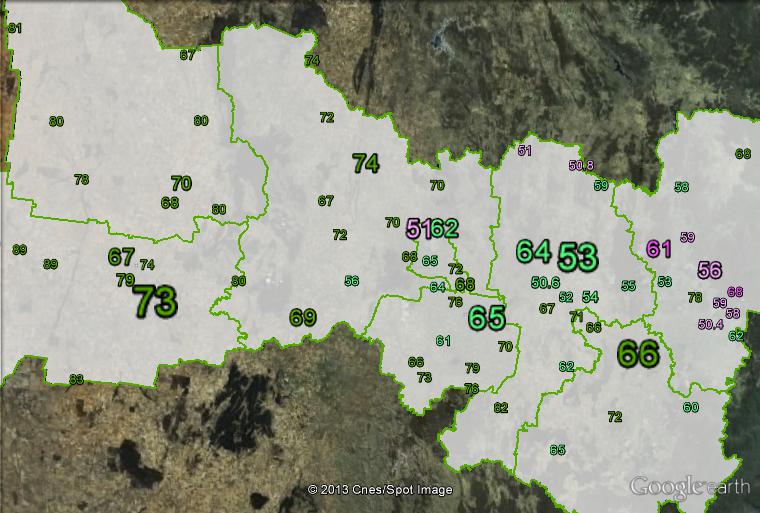
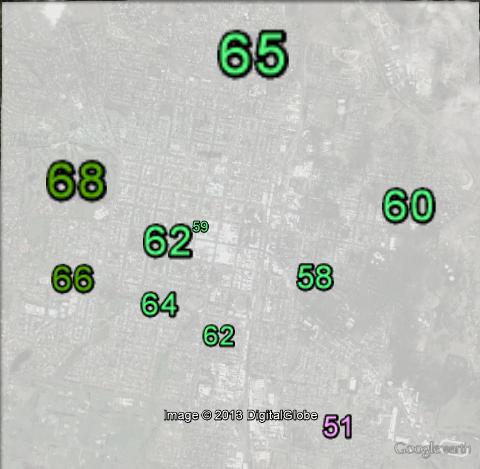
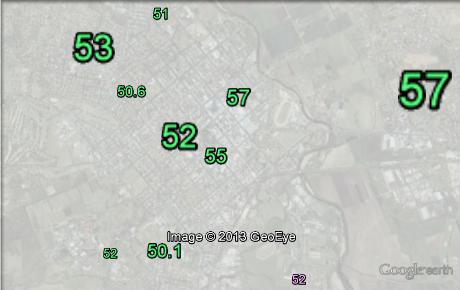
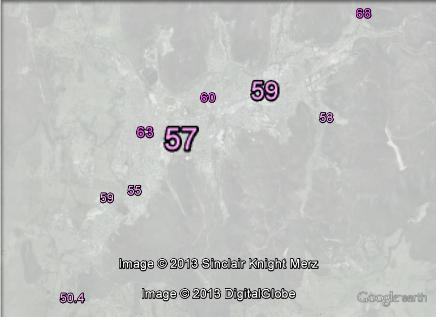
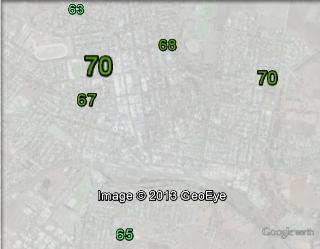


Andren’s autobiography “The Andren Report” is a pretty good read if you’ve got a spare few hours. Covers his pre-politics life and career up to the 2004 election.
What caused the massive swing here?
An independent polled 23% in Calare in 2007. The disappearance of that vote partly explains the swing to the Nats.
There’s also the repeated shifting around of this seat at the redistributions before 2007 and 2010. Half the seat spent a term in Macquarie (held by a Labor MP who retired in 2010), and the continuing half had temporarily been in a very safe National seat, so maybe Labor ignored it for that reason. Or maybe they were just too fixated on western Sydney. A map of the swings could be interesting.
PS: “Lithgow in orange and Orange in yellow”? That’s not confusing at all. 😛
Yes, I suppose you are right.
I’ve just noticed that some of the maps run off the side – I’ll fix that up tonight.
Bathurst & Lithgow were added by 1977 redistribution I think. Significant that Labor polling so badly in seat held by them on these boundaries 1983-96.
During Peter Andren’s tenure of the seat, count-backs that notionally distributed his preferences (I recall) indicated fairly narrow Coalition wins – so it was otherwise a marginal seat owing to a strong ALP vote in Lithgow. The 1977 redistribution had transformed Calare from a safe conservative seat to a marginal.
The notional figures for this seat on the 2010 boundaries using 2007 results had the Nats winning with only 53.5% – that was quite marginal. It’s not inconceivable this seat could be marginal again next time there’s an upswing for Labor.
The ALP candidate is Bathurst councillor Jess Jennings
http://www.westernadvocate.com.au/story/1271444/bathursts-new-councillor-alp-candidate-for-calare/
I think you’ve left out the ‘other votes’ row in the booth breakdown table???
Hi Ben, I think that what you are refering to is that in 2007 the Liberal Party contested the booths in Lithgow and Bathurst as Macquarie included the areas around Oberon, Bathurst and Lithgow in the 2007 Election.
Hope that this helps.
Oh yes, of course. That makes sense.
RE Calare…….. the ALP vote in Lithgow, Bathurst and East Orange should make that seat very marginal but it did not………there has been a serious decline in the Alp vote
with struggling local business, I expect many of those stakeholders to experiment with the PUP being one of the very few NSW seats that PUP does OK in.
Considering the blue collar vote in lithgow and bathurst plus orange’s 25 percent one nation vote in 98 i think katter may do well here. Katter will appeal more than palmer
Yeah I’d like Katter’s chances here. Might even finish 2nd.
I am interested in how katter goes outside queensland. It is really hard to tell. So can kap get 15 or 25 percent in calare, hunter, shortland etc
I don’t think Katter will have any influence outside of QLD. But if he does, then I suspect it will assist the Coalition more than Labor, where as, Palmer is the reverse.
Calare is not the sort of seat that will provide Katter with much of a boost. If he gets 5% of the vote in the electorate he will do well I reckon.
again inflated margin…..60% with 7% swing in 2010
put the former state mp for Bathurst’s figures here 60% of half the electorate
would be very close
Howse VC was the first Australian to be awarded the Victoria Cross. He was a medical officer in the Anglo-Boer War. During WW1 he was the force behind the re-organise the 1st AIF medical services and contributed greatly to the repatriation of soldiers back to Australia.
In the Commonwealth Parliament he served as both Health and Defence Minister at different times in the 1920’s.
“Neville Howse’ by Michael B Tyquin – Oxford University Press – 1999 is an excellent read
David Mallard has been announced as the Greens candidate
http://www.westernadvocate.com.au/story/1695387/a-new-face-in-calare-race/?cs=115